Speed, Velocity, Acceleration Lesson Plan - A Complete Science Lesson Using the 5E Method of Instruction
By the end of this comprehensive lesson about speed, velocity, and acceleration, students will be able to calculate average speed using distance and time measurements. They will also be able to differentiate between speed, velocity, and acceleration. Each of our lessons is designed using the 5E method of instruction to ensure maximum comprehension by the students. This well-thought out unit does the heavy lifting, giving teachers easy-to-implement, highly engaging lesson plans.
This blog will walk you through each of the steps and activities of the Speed, Velocity, and Acceleration 5E Lesson Plan.
ENGAGEMENT
Objective Introduction
At the beginning of the lesson, the class will do a Think-Pair-Share to discuss the objective.
Class Activity
Show a video using a link provided with the 5E lesson you purchased.
Student Activity
- Have the students work with a partner to write a description of this race using the words:
- Speed
- Constant Speed
- Average Speed
- Velocity
- Acceleration
- Ask for volunteers to read their descriptions.
- Explain that over the next few days students will be learning about the difference between speed, velocity, and acceleration, and how to calculate average speed.
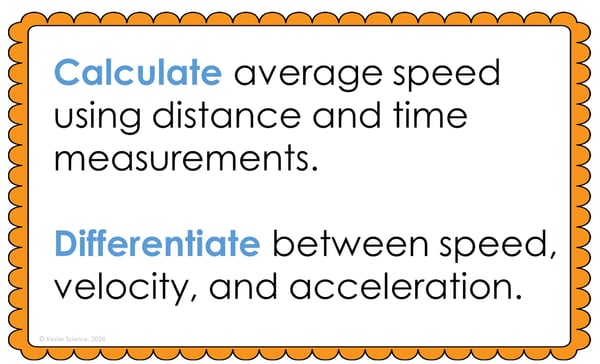
The teacher will help to clear up any misconceptions their students have about speed, velocity, and acceleration. A major and common misconception, for example, is that students think of velocity as just another word for speed. An object’s speed and velocity are always the same. Acceleration is confused with speed. Acceleration always means that an object is speeding up.
Estimated Class Time for the Engagement: 20-30 minutes
EXPLORATION
This student-centered station lab is set up so students can begin to explore average speed. With nine stations in total, you can introduce speed, velocity, and acceleration to your middle school students in a variety of ways! Four of these stations are considered input stations where students will learn new information about speed, velocity, and acceleration, and four of the stations are output stations where students will be demonstrating their mastery of the lesson's material. A bonus station offers challenges for your early finishers and independent learners. You can read more about how I set up the station labs here.
Watch It!
At this station, students will be watching a short video explaining how to calculate the average speed. Students will then answer questions related to the video and record their answers on their lab station sheet. For example: Millimeters, centimeters, meters, kilometers, inches, feet, and miles are all examples of? What is the formula for calculating average speed? What is the average speed of a car that travels 540 miles in six hours?
Read It!
This station will provide students with a one-page reading about average speeds of certain sport cars. Students will get learn about average speeds of cars like the Hennessey Venom GT, Bugatti Veyron Super Sport, and the Koenigsegg Agera R. There are four follow-up questions that the students will answer to demonstrate their comprehension of the reading material.
Explore It!
Students will be working in pairs to better understand calculating average speeds. In this station, students become the objects as they conduct certain tasks. Students will then calculate their average speeds as they try to complete their tasks. Students will follow the steps and record their observations on their lab sheet.
Research It!
The research station will allow students to explore an interactive web page that calculates the average speeds of objects. Students will enter information from the task cards into the website and see how it calculates information for them. Students will be instructed to complete a few tasks and record answers on their lab sheets.
Organize It!
Students at this station will have to categorize sets of cards as describing either distance, time, or average speeds. Once students have completed their organization, the teacher will check their understanding.
Illustrate It!
Your visual students will love this station. Students are to draw a picture that demonstrates their knowledge of average speed. They will need to label time, distance, and average speed on their drawings.
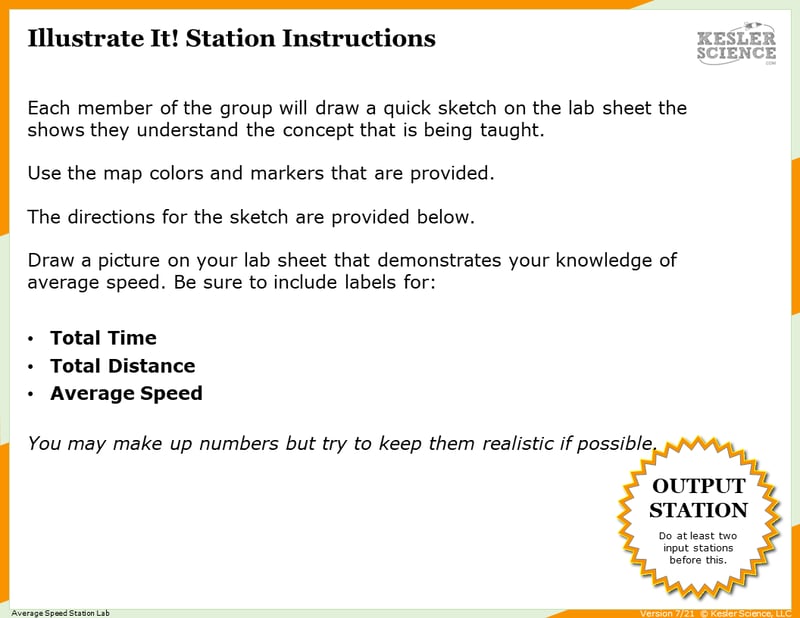
Write It!
Students who can answer open-ended questions about the lab truly understand the concepts that are being taught. At this station, the students will be answering three task cards: What two pieces of information must you have in order to calculate the average speed of an object? Describe in your own words how to calculate average speed. What will happen to the average speed of an object if the distance increases, but the time decreases?
Assess It!
The Assess It station is where students will go to prove mastery over the concepts they learned in the lab. The questions are set up in a standardized format with multiple choice answers. Some questions include: What is the average speed of a baseball that is thrown 90 feet in 2 seconds? What two things are needed to determine average speed? Calculate the average speed of a boat that travels 600 meters in 40 seconds. What is the average speed of the object at 8 seconds?

Challenge It! - Bonus Station
Early finishers and advanced students will love the extension activities in this station. Four activity choices offer them ways to expand their learning through mini-games and mini-projects.
Estimated Class Time for the Exploration: One or two 45-minute class periods
EXPLANATION
The explanation activities will become much more engaging for your class once they’ve completed the exploration station lab. During the explanation piece of the lesson, the teacher will be clearing up any misconceptions their students may have about speed, velocity, and acceleration with a variety of materials. These materials include on-level and modified versions of the interactive presentation (may be used individually or projected), anchor charts, and paper or digital interactive notebook activities. If you have students that need modified notes, the 5E lessons come equipped to help give every student access to the lesson.
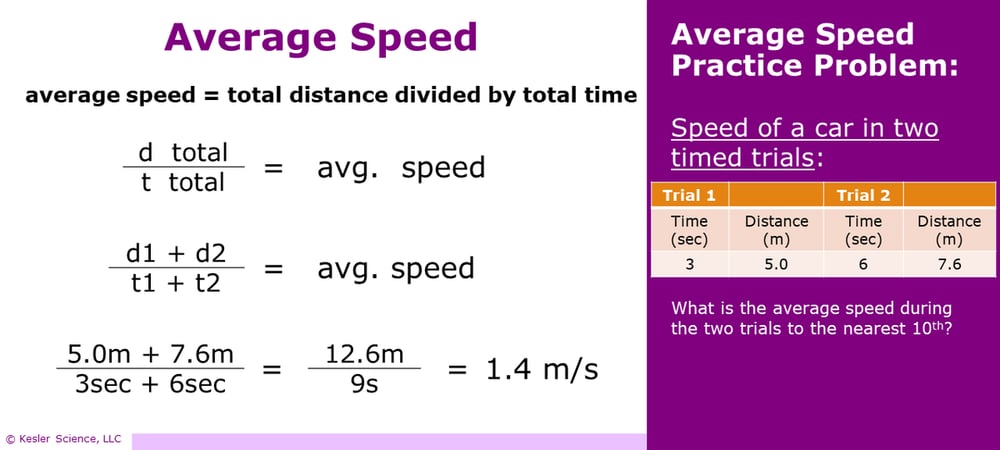
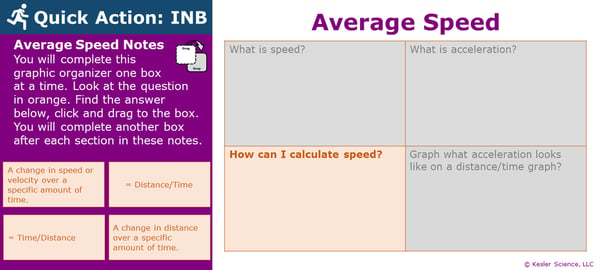
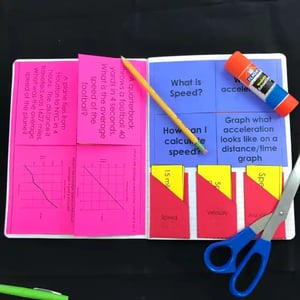
The students will also be interacting with their journals while taking notes from the PowerPoint. If you have students that need modified notes, the 5E lessons come equipped to help give every student access to the lesson.
Estimated Class Time for the Exploration: Two or three 45-minute class periods
ELABORATION
The elaboration section of the 5E method of instruction gives students choices that allow them to prove they’ve mastered the concepts behind the lesson. When students are given a choice, they’re much more enthusiastic and invested in the project than they are when their teachers choose their projects for them. There are a total of nine choices to demonstrate understanding of speed, acceleration, and velocity. A separate set of choices that offer more teacher support are also available for students that need them. Rubrics guide students to doing their best work and assist in grading.
Estimated Class Time for the Elaboration: Two or three 45-minute class periods (can also be used as an at-home project)
EVALUATION
The final piece of the 5E model is to evaluate your students' comprehension. Included in every 5E lesson is a homework assignment, assessment, and modified assessment. Research has shown that homework needs to be meaningful and applicable to real-world activities in order to be effective. When possible, I like to give open-ended assessments to truly gauge the student’s comprehension.
Estimated Class Time for the Elaboration: One 45-minute class period
DOWNLOAD THE FULL LESSON NOW
Download Over $100 in FREE Resources
For Middle School Science
Simply create a login below and gain immediate access to a selection of our Kesler Science product line worth $100 - for FREE. There's a full version of every product type! You'll also join tens of thousands of middle school science teachers who receive timely tips and strategies straight to their inbox.







